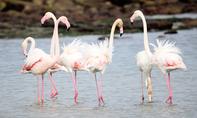
Name
Greater flamingo (Phoenicopterus ruber)Greater Flamingo Appearance
The greater flamingo is an easily recognised slender large bird, up to 1.5 m tall. It has a pale pink to white plumage, with a long neck and long pink legs. In flight the crimson red and black wings are highly conspicuous, these are occasionally visible when the bird is on the ground.The bill is pink with a black tip. The greater flamingo has a yellow eye.
Greater Flamingo Diet
The greater flamingo feeds on aquatic invertebrates such as brine shrimp and algae. When feeding the greater flamingo can be seen with its head down or submerged in the water, using its legs to stir up the mud to release the algae and organisms, that are then filtered through the beak.Greater Flamingo Breeding
The greater flamingo is monogamous but does breed with a different partner each year. A single egg is laid in a cone mud nest. The egg is incubated for around 30 days by both parents. After hatching the chick spends around 4 days on the nest, then joins a huge “crèche” with all the other chicks in the colony, looked after by a few adult caretakers.Greater Flamingo Behaviour
The greater flamingo is highly gregarious and will not breed unless large numbers of flamingos are present. An elaborate group courtship display is performed that involves synchronised wing raising, preening, marching and head turning.The greater flamingo is highly nomadic and partially migratory.
Greater Flamingo Threats
Listed as near threatened. The primary threat to the greater flamingo is habitat destruction due to pollution in the water and encroachment.Greater Flamingo Distribution and Habitat
Greater flamingos are found on large, shallow bodies of water. They prefer saline or brackish water.This bird can be seen across South Africa but is absent from arid areas and most of KwaZulu-Natal. The best area to see this bird is Kamfers Dam near Kimberley, Schuinsdraai Nature Reserve near Tzaneen and the West Coast National Park near Cape Town.